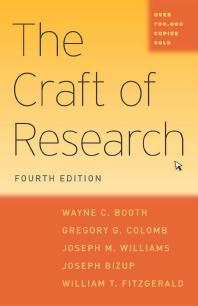Finding a Topic
The answers to these four questions will help define your research project or topic:
- What are you going to do? The subject of your research.
- Why are you going to do it? The reason for this research being necessary or interesting.
- How are you going to do it? The research methods that you will use to carry out the project.
- When are you going to do it? The programme of the work.
When searching for information on your topic, it is a good idea to take time to develop a search strategy. Such a strategy will not only save you time in the long run, but it will go a long way toward ensuring that you retrieve everything that is pertinent to your research topic.
• Create a search statement using keywords or main concepts
• Use databases to find literature on your topic. Checking more than one database can be very useful to pick up unique titles
• Use keywords and controlled language (i.e., subject headings) when searching
• Use Boolean searching (i.e., combine your terms with AND, OR, NOT to broaden or narrow your results)
• Change approaches as necessary – gathering information is not a linear process
• Continue to identify applicable keywords and controlled vocabulary to go back and check in the selected database(s) and other resources
Citation tracing as a search strategy
Another good way to discover sources relevant to your research question or topic is to check the citations and bibliographies in books, articles, and dissertations related to your project. Whether citations appear as endnotes or footnotes, they can be very helpful in leading you to primary sources found in archives, as publications, on microfilm, and online.
Bibliographies in books and dissertations often separate out lists of the primary or archival sources consulted, and if you are lucky, you might find a bibliographic essay at the end of a book or dissertation that not only identifies primary source materials but also describes the type and quality of information they contain.
TIP: Use Bibliographies
Read the background information and note any useful sources (books, journal, etc.) listed in the bibliography at the end of the encyclopedia article or dictionary entry. The sources cited in the bibliography are good starting points for further research
Look up these sources in the catalog and databases. Check the subject heading listed in the subject field of the record for these books and articles. Then do subject searches using those subject headings to locate additional titles.
Remember that many of the books and articles you find will themselves have bibliographies. Check these for addtional useful resources for your search.
By using this technique of routinely following up on sources cited in bibliographies, you can generate a surprisingly large number of books and articles on your topic in a relatively short time.

The Research Process
STEP 1: IDENTIFY AND DEVELOP YOUR TOPIC
State your topic as a question. For example, if you are interested in writing about romanticism in Baudelaire's poetry, you might pose the question, "In what way did the romanticism of Charles Baudelaire differ from his contemporaries like Shelley and Keats?" Identify the main concepts or keywords in your question.
STEP 2: FIND BACKGROUND INFORMATION
Look up your keywords in the indexes to subject encyclopedias. Read articles in these encyclopedias to set the context for your research. Note any relevant items in the bibliographies at the end of the encyclopedia articles. Additional background information may be found in your lecture notes, textbooks, and reserve readings.
STEP 3: USE CATALOGS TO FIND BOOKS AND MEDIA
Use keyword searching to find materials by topic or subject. Print or write down the citation (author, title,etc.) and the location information (call number and library). Note the circulation status. When you pull the book from the shelf, scan the bibliography for additional sources. Watch for book-length bibliographies and annual reviews on your subject; they list citations to hundreds of books and articles in one subject area. Check the standard subject subheading "--BIBLIOGRAPHIES," or titles beginning with Annual Review of... in the Library Catalog.
STEP 4: USE INDEXES OR DATABASES TO FIND ARTICLES
Use indexes or databases to find citations to articles. These may be in print or electronic formats, or both. Choose the indexes and format best suited to your particular topic. If the full text is not linked in the database you are using, write down the citation from the index and search for the title of the journal in the Library Catalog.
Watch on YouTube: How to read citations
STEP 5: FIND ADDITIONAL INTERNET RESOURCES
Nearly everyone is aware of and uses Google and its branches, Google Scholar, Google Books, Google News, YouTube, etc., to search and find information on the open Internet (as opposed to the subscription-only resources you will encounter in steps 2 through 4 above).
STEP 6: EVALUATE WHAT YOU FIND
SUMMARY: See the tab "Evaluating Sources" in this guide for suggestions on evaluating the authority and quality of the books and articles you located.
Watch on YouTube: Identifying scholarly journals Identifying substantive news sources
If you have found too many or too few sources, you may need to narrow or broaden your topic.
STEP 7: CITE WHAT YOU FIND USING A STANDARD FORMAT
Give credit where credit is due; cite your sources.
Citing or documenting the sources used in your research serves two purposes, it gives proper credit to the authors of the materials used, and it allows those who are reading your work to duplicate your research and locate the sources that you have listed as references.
Knowingly representing the work of others as your own is plagarism. Use MLA or another style approved by your instructor. KU's policy on academic integrity is here .
Kodjo Atiso
The Craft of Research
-
 The Craft of Research
by
Call Number: E-bookISBN: 9780226239873Publication Date: 2016-10-284th edition
The Craft of Research
by
Call Number: E-bookISBN: 9780226239873Publication Date: 2016-10-284th edition
